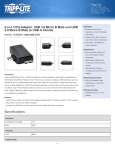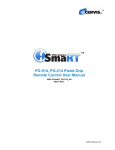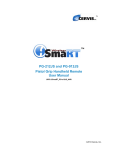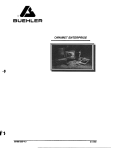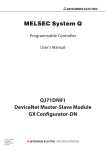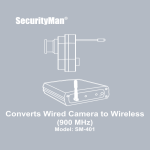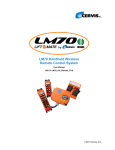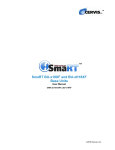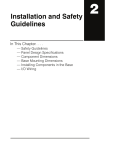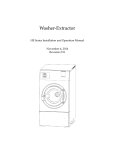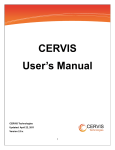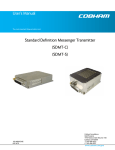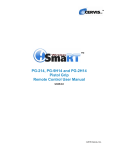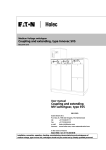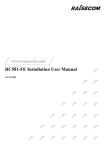Download SmaRT 18 Button Manual
Transcript
™ ™ SmaRT 918, 218 Remote Control System User Manual U053.4-SmaRT_OO-x18_Sys 2012 Cervis, Inc. SmaRT 218, 918 This document is the property of Cervis, Inc. and cannot be copied, modified, e-mailed, or reproduced without the express prior written consent of Cervis, Inc. Cervis, Inc. reserves the right to change this manual or edit, delete, or modify any information without prior notification. FCC Statements 15.19 – Two Part Warning This device complies with Part 15 of the FCC rules. Operation is subject to the following two conditions: (1) This device may not cause harmful interference and (2) This device must accept any interference received, including interference that may cause undesired operation. 15.21 – Unauthorized Modification NOTICE: The manufacturer is not responsible for any unauthorized modifications to this equipment made by the user. Such modifications could void the user’s authority to operate the equipment. 15.105(b) – Note: This equipment has been tested and found to comply with the limits for a Class B digital device, pursuant to Part 15 of the FCC Rules. These limits are designed to provide reasonable protection against harmful interference in a residential installation. This equipment generates, uses and can radiate radio frequency energy and, if not installed and used in accordance with the instructions, may cause harmful interference to radio communications. However, there is no guarantee that interference will not occur in a particular installation. If this equipment does cause harmful interference to radio or television reception, which can be determined by turning the equipment off and on, the user is encouraged to try to correct the interference by one or more of the following measures: • Reorient or relocate the receiving antenna. • Increase the separation between the equipment and receiver. • Connect the equipment into an outlet on a circuit different from that to which the receiver is connected. Industry Canada Statement This device complies with Canadian RSS-210. The installer of this radio equipment must ensure that the antenna is located or pointed such that it does not emit RF field in excess of Health Canada limits for the general population; consult Safety Code 6, obtainable from Health Canada’s website www.hc-sc.gc-ca/rpb. Cervis, Inc. Visit our Web site at: www.cervisinc.com 2012 Cervis, Inc. All rights reserved. Content is subject to change without notice. Remote Control System Table of Contents Cervis Inc. Safety Precautions ................................................................................................... 1 1.0 SmaRT 218, 918 Remote Control System .......................................................................... 3 2.0 SmaRT x18 18-Button Handheld Remote Control ............................................................ 4 2.1 Features ............................................................................................................................. 4 2.2 SmaRT x18 Handheld Battery Installation ..................................................................... 5 2.3 Low Battery Warning ........................................................................................................ 5 2.4 Low Battery Auto-Shutdown ........................................................................................... 6 3.0 SmaRT OO-x18 Operation ................................................................................................... 7 4.0 Associate Mode .................................................................................................................... 8 5.0 BU-X16F Base Unit............................................................................................................... 9 5.1 BU-X16F Base Unit Installation ..................................................................................... 10 6.0 Specifications ..................................................................................................................... 13 7.0 BU-x16F Output Current Derating Curve ......................................................................... 15 8.0 Base Unit Troubleshooting ............................................................................................... 16 List of Figures Figure 1. Standard SmaRT x18 System ....................................................................................... 3 Figure 2. SmaRT x18 18-Button Handheld Remote Control Unit .............................................. 4 Figure 3. OO-x18 Handheld Battery Compartment ..................................................................... 5 Figure 4. Low Battery Warning and Auto-Shutdown .................................................................. 6 Figure 5. Handheld Buttons .......................................................................................................... 7 Figure 6. Associate Mode .............................................................................................................. 8 Figure 7. SmaRT BU-X16F LEDs................................................................................................... 9 Figure 8. Internal and External Antenna Base Unit Dimensions ............................................. 10 Figure 9. Base Unit Field Wiring ................................................................................................. 11 Figure 10. Field Wiring ................................................................................................................. 12 Figure 11. Base Unit Output Current Derating Curve ............................................................... 15 List of Tables Table 1. Handheld Button to BU I/O Mapping ............................................................................. 7 Table 2. SmaRT x18 18-Button Handheld Specifications ........................................................ 13 Table 3. SmaRT BU-X16F Base Unit Specifications ................................................................. 14 Table 4. Base Unit LED Troubleshooting .................................................................................. 16 2012 Cervis, Inc. i SmaRT 218, 918 Definitions/Notes Associate/Association Mode where by SmaRT handhelds and base units are paired for operation (ID’s exchanged). This mode is used to commission spare handhelds or base units. DSSS Direct sequence spread spectrum; an advance wireless communication technology. Disassociation The process of decommisioning a handheld from a base units ID memory. PTO Push-to-Operate: Command broadcast only while a button is depressed. The command ends when the button is released. Latch Command broadcast while a switch is placed in position or when a button is pressed. The command ends when switch is repositioned or when the button is released, or in some cases when the button is pressed again. SmaRT Base Unit I/O unit to which the controlled machine is connected. SmaRT base units communicate with each other and SmaRT handheld, console, and 18-Button Handheld remote controllers. SmaRT x18 Remote Control System SmaRT wireless remote control system consisting of one or more SmaRT base units and a SmaRT 18-button remote control unit that controls the base unit input and output functions. The system operates either in the 900MHz or 2.4GHz range. Line of Sight (aka Direct-Line-of-Sight) Term used to describe RF communication where the pathway between the units is clear of physical obstacles such as walls, earth, and other obstructions. TX/RX Transmit/Receive Contact us with questions during installation or troubleshooting at (724) 741-9000 ii U053.4-SmaRT_OO-x18_Sys Remote Control System Cervis Inc. Safety Precautions Read and follow all instructions. Failure to abide by Safety Precautions may result in equipment failure, loss of authority to operate the equipment, and personal injury. Use and maintain proper wiring. Follow equipment manufacturer instructions. Improper, loose, and frayed wiring can cause system failure, equipment damage, and intermittent operation. Changes or modifications made to equipment not expressly approved by the manufacturer will void the warranty. Owner/operators of the equipment must abide by all applicable Federal, State, and Local laws concerning installation and operation of the equipment. Failure to comply could result in penalties and could void user authority to operate the equipment. Make sure that the machinery and surrounding area is clear before operating. Do not activate the remote control system until certain that it is safe to do so. Turn off the handheld remote and remove power from the base unit before attempting any maintenance. This will prevent accidental operation of the controlled machinery. Power can be removed from the Base Unit by detaching the 12-pin cables from the base unit connectors P1 and P2, or by removing the source power from the circuit. Use a damp cloth to keep units clean. Remove mud, concrete, dirt, etc. after use to prevent obstructing or clogging the buttons, levers, wiring, and switches. Do not allow liquid to enter the handheld or base unit enclosures. Do not use high pressure equipment to clean the handheld remote or base unit. Disconnect the radio base unit before welding on the machine. Failure to disconnect the base unit may result in destruction of or damage to the base unit. Operate and store units only within the specified operation and storage temperatures defined in 6.0 Specifications of this document. SmaRT 218, 918 The following applies only to SmaRT 218 18-Button Handheld remote control systems. RoHS Compliance Statement Cervis, Inc. complies with the requirements of Restriction of Hazardous Substances (RoHS/WEEE) Specification based on in-house practice and declaration of compliance from our vendors. For additional information concerning RoHS compliance, please contact Cervis, Inc. at: CERVIS, Inc. 170 Thorn Hill Road Warrendale, PA 15086 Phone: 724.741.9000 Fax: 724.741.9001 This product may contain material that may be hazardous to human health and the environment. In compliance with EU Directive 2002/96/EC on Waste Electrical and Electronic Equipment (WEEE): Do not dispose of the product as unsorted municipal waste. This product should be recycled in accordance with local regulations. Contact local authorities for detailed information. This product may be returnable to the distributor for recycling. Contact your distributor for details. 2 U053.4-SmaRT_OO-x18_Sys Remote Control System 1.0 SmaRT 218, 918 Remote Control System Note: Frequency of operation for a SmaRT system will be either in the 900MHz or 2.4GHz range. The first number in the name of the system or device indicates the frequency of operation. For instance, a SmaRT 18-button handheld remote with an ON button and an OFF button will either be OO-218 or OO-918, where a 2 indicates 2.4GHz and 9 indicates 900MHz. As such, reference to the system, handheld remote, and base unit in this manual will use x in the name (rather than a 2 or 9) to indicate the frequency of operation. A standard SmaRT x18 Remote Control System consists of a SmaRT OO-x18 18button handheld remote control unit and a BU-x16F base unit. A SmaRT system is capable of communicating in congested radio environments using Direct Sequence Spread Spectrum (DSSS) wireless technology at a system dependant 900MHz or 2.4GHz range. The system communication link between the handheld remote control and the base unit is established at the factory using a process known as Association. The system can also be seamlessly associated in the field without the need to open the enclosures of either unit by a wireless process described later in this manual. The OO-x18 handheld remote has a dedicated ON button and an OFF button. The remaining sixteen buttons are assigned to and used to control the base unit outputs. The BU-x16F base unit has sixteen solid state FET channels. System configuration is extended as the I/O can also be custom configured by Cervis Engineering to be inputs or outputs. Figure 1. Standard SmaRT x18 System 2012 Cervis, Inc. 3 SmaRT 218, 918 2.0 SmaRT x18 18-Button Handheld Remote Control The SmaRT™ x18 18-Button Handheld Remote is designed for traditional and nontraditional mobile applications capable of activating and deactivating the input/outputs of SmaRT base units. The handheld remote is capable of providing single-handed operation in a comfortable ergonomic layout. Using direct sequence spread spectrum (DSSS) wireless technology at the 900MHz or 2.4GHz (system dependant) range to communicate, the SmaRT 18-button handheld remote provides a robust link with a base unit in congested radio environments. The handheld remote allows seamless association to a SmaRT base unit without the need to open the case of either unit. The rugged weatherproof handheld enclosure allows the unit to operate worry free in harsh weather conditions. Figure 2. SmaRT x18 18-Button Handheld Remote Control Unit 2.1 Features 4 Uses direct sequence spread spectrum technology (DSSS) at 900MHz or 2.4GHz Direct-line-of-sight operation Individual On and Off buttons with 16-button function control Three LED indicators Low voltage warning LED indication Critical low voltage auto-shutdown Rugged high-impact polymer/polycarbonate/stainless steel enclosure Optional removable protective bumper and lanyard Weatherproof design Operates at 1.6 – 3.2VDC (uses four AA batteries) U053.4-SmaRT_OO-x18_Sys Remote Control System 2.2 SmaRT OO-x18 Handheld Battery Installation The handheld remote operates between 1.6 to 3.2VDC powered by four factory installed 1.5V AA alkaline batteries. Cervis, Inc. recommends that fresh spare batteries be at hand at all times that the system is in use. Note: The battery cover is designed so that the four screws holding the battery cover in place are ‘captive’ to the cover. Although not easily removed from the cover itself, be aware that if the screws are over-loosened while opening the battery compartment, they can be completely removed increasing the risk of loss. All four screws must be installed to maintain a tight seal. 1. Place the remote face down and remove the four screws holding the battery cover in place. Remove the battery cover. 2. Remove the discharged batteries and properly dispose in accordance with local regulations. 3. Plug each fresh battery into a terminal cradle observing proper polarity. The interior of the cradle shows polarity markings for each terminal. Make sure the batteries are firmly seated in the cradle. 4. Replace the battery cover. Secure the cover with the four screws. Make sure they are tightened enough to compress the seal, but be careful not to over-tighten. Figure 3. OO-x18 Handheld Battery Compartment Observe proper polarity when placing batteries into the cradle. Improper battery placement can result in excessive heat, battery explosion, injury to the operator, and damage to the remote. Note: Cervis, Inc. recommends that the batteries be removed from the handheld remote when the remote is going to be stored for any extended length of time. 2012 Cervis, Inc. 5 SmaRT 218, 918 2.3 Low Battery Warning When low voltage is sensed—approximately 1.7V—the AMBER RX LED will no longer indicate that there is an incoming message. Instead, the LED will begin to flash approximately once per second indicating a Low Battery Warning. Messages are still being received, and the handheld can still be used, but it is recommended that a fresh set of four AA batteries should be installed as soon as possible. LOW BATTERY WARNING At Low Voltage, the AMBER RX LED stops flashing as messages are received by the handheld remote from the base unit. Messages are still being received, but they are not indicated by the LED. The RX LED begins flashing once per second indicating a LOW BATTERY situation is present. The batteries should be replaced with four fresh AA batteries as soon as possible. The LED will continue to flash at one second intervals until the batteries are changed, or until the voltage level drops to the level where Auto-Shutdown occurs. LOW BATTERY AUTO-SHUTDOWN As the critical Auto-Shutdown voltage is sensed, the AMBER LED stops flashing. The RED LED flashes for approximately 30 seconds indicating the handheld remote is automatically shutting down. The four AA batteries must be replaced before the handheld can be used again. Figure 4. Low Battery Warning and Auto-Shutdown 2.4 Low Battery Auto-Shutdown When the critical Auto-Shutdown voltage is sensed (approximately 1.6VDC), the AMBER RX LED will stop pulsing, the handheld will no longer communicate with the base unit, the RED LED will pulse for approximately 30 seconds indicating the handheld remote is about to completely shut down. The four AA batteries must be replaced before the handheld remote can be used. 6 U053.4-SmaRT_OO-x18_Sys Remote Control System 3.0 SmaRT x18 Operation Turn ON the Unit The remote is powered ON by pressing the Green and White ON button . Turn OFF the Unit The remote is turned OFF by pressing the Red and White OFF button . Buttons 1 through 16 Buttons 1 through 16 are used for control of the base unit. These buttons are typically mapped to specific base unit outputs/inputs M1 through M16 as shown below. Buttons 1 (M1) through 16 (M16) are used for function control. ON OFF Button 1 2 3 4 5 6 7 8 9 10 11 12 13 14 15 16 BU Map M# M1 M2 M3 M4 M5 M6 M7 M8 M9 M10 M11 M12 M13 M14 M15 M16 I/O Channel Ch1 Ch2 Ch3 Ch4 Ch5 Ch6 Ch7 Ch8 Ch9 Ch10 Ch11 Ch12 Ch13 Ch14 Ch15 Ch16 BU Connector P# and Pin # P2–9 P2–10 P2–11 P2–12 P2–1 P2–2 P2–3 P2–4 P1–3 P1–4 P1–5 P1–6 P1–7 P1–8 P1–9 P1–10 Table 1. Handheld Button to BU I/O Mapping Figure 5. Handheld Buttons 2012 Cervis, Inc. 7 SmaRT 218, 918 4.0 Associate Mode The Associate Mode is used to establish the communications link between the 18-button handheld remote and base unit on a 1-to-1 basis. There must be a clear line of sight between the handheld and the base to associate, and both units must be OFF (powered down). The 18-Button Handheld is turned off by pressing the OFF button. The SmaRT base unit is safely powered down by removing the power source from the unit. OFF To prevent inadvertent movement of the machine, be sure to remove power from the Base Unit before attempting to enter Associate Mode. Observe LED states while performing the following Association: Figure 6. Associate Mode 1. Remove power from the base unit and turn off the handheld. 2. Stand near the base unit with the handheld in clear line-of-sight. 3. Press and hold button 12, then press and hold the ON button. LEDs #1 (green), #2 (amber), and #3 (red) light solid. 4. Continue to hold both buttons until the Amber LED (#2) goes OUT. Immediately release both the ON and 12 buttons. You have approximately 2 seconds to perform the next step. If you miss this window of opportunity, you must restart this procedure starting at Step 3. 5. Press and hold button 1. Wait until the Amber LED #2 goes out. 6. Turn the base unit ON while holding button 1. LEDs illuminate. 7. When the Red LED #3 goes out, release button 1. If the Association is successful, green LED #1 and amber LED #2 will continually flash (TX and RX respectively) indicating that the handheld and the base unit are communicating. Note: The label on early versions of the OO-x18 handheld remote indicated eight LED places numbered left-to-right as 1 though 8 respectively as opposed to the current six LED places shown throughout this manual, which are numbered from left-to-right as 1 though 6. LED numbers 2 (green), 3 (amber), and 4 (red) were the active LEDs on the eightplace units, which respectively relate to active LED numbers 1 (green), 2 (amber), and 3 (red) in the current version shown in this manual. 8 U053.4-SmaRT_OO-x18_Sys Remote Control System 5.0 BU-X16F Base Unit Health OK Green pulse/sec Power OK Amber Green when an output is active Amber or Red when there is an output issue TX/RX Green/Amber when transceiving Figure 7. SmaRT BU-X16F LEDs The SmaRT™ BU-x16F features sixteen FET, high side switching outputs or switch-toground digital inputs. The versatile, programmable digital inputs can be customized by Cervis to fit specific user applications. The BU-X16F accepts a broad range of input power with operating voltages ranging from 7VDC to 32VDC. The rugged weatherproof enclosure allows the unit to operate worry free in harsh weather conditions. Two models of connecting cables are available for P1 and P2 of the base unit. SmaRT™ base units feature seamless association to a SmaRT™ hand-held unit without the need to open the case. Using Direct Sequence Spread Spectrum (DSSS) wireless technology at a system dependant 900MHz or 2.4GHz, the base unit provides a robust link in congested radio environments. Features • • • • • • • Uses 900MHz or 2.4GHz direct sequence spread spectrum technology Sixteen FET outputs/inputs +7 to +32VDC power Dual connector interface for ease of wiring Diagnostic LEDs Compact design Rugged, weatherproof construction 2012 Cervis, Inc. 9 SmaRT 218, 918 5.1 BU-X16F Base Unit Installation Make sure the machine that the base unit is to be installed is disabled during installation. Use the configuration diagrams supplied by Cervis as a guide when mounting the base unit and connecting the wiring harnesses. Dimensions for drilling mounting holes are shown in Figure 8. Wiring harness connections are shown in Figure 9 below. Internal Antenna Unit P1 P2 133mm (5.25”) 36mm (1.4”) 7.4mm (0.29”) dia. External Antenna Unit 7.4mm (0.29”) dia. 102mm (4”) centers 118mm (4.7”) 183mm 7.2” 900 MHz Ant. 115 mm 4.57” 2.4GHz Ant. 118mm (4.7”) 180mm (7.08”) Figure 8. Internal and External Antenna Base Unit Dimensions 10 U053.4-SmaRT_OO-x18_Sys Remote Control System NOTE: P1 and P2 are uniquely keyed to Prevent cross connection. NOTE: +VDC Battery/Power Supply Positive −VDC Battery/Power Supply Negative ON (1) M5 (button #5) (2) M6 (button #6) (3) M7 (button #7) (4) M8 (button #8) (5) UNUSED (6) UNUSED (7) +VDC (8) UNUSED (9) M1 (button #1) (10) M2 (button #2) (11) M3 (button #3) (12) M4 (button #4) (1) +VDC (2) UNUSED (3) M9 (button #9) (4) M10 (button #10) (5) M11 (button #11) (6) M12 (button #12) (7) M13 (button #13) (8) M14 (button #14) (9) M15 (button #15) (10) M16 (button #16) (11) UNUSED (12) — VDC OFF Handheld remote buttons #1 through #16 are typically mapped to base unit outputs/Inputs M1 through M16 respectively. Figure 9. Base Unit Field Wiring 2012 Cervis, Inc. 11 SmaRT 218, 918 Field Load Field Load Field Load Field Load Field Load Field Load Field Load Field Load Field Load Field Load Field Load Field Load Field Load Field Load Field Load Field Load Figure 10. Field Wiring 12 U053.4-SmaRT_OO-x18_Sys Remote Control System 6.0 Specifications Table 2. SmaRT x18 18-Button Handheld Specifications Item Power Environment Description Vin +1.6V to +3.2VDC Batteries Battery Life Low V Warning Low V Shutdown Auto-shutdown Four (4) AA 175 to 200 hours ~1.7VDC 1.6VDC 15 min. of button inactivity Operating Temp -20°C to 55°C (-4°F to 131°F) Radio Storage Temp -40°C to 55°C Humidity (-40°F to 131°F) 0 to 100% Frequency 906-924MHz 2405-2480MHz Enclosure Indicators (4) 900MHz RF Power 1mW 2.4GHz RF Power 2mW License License free Modulation Antenna DSSS Internal Dimensions 9 ⅛” x 3 ⅛” x 1 ¼ ” (231.8 mm x 79.4 mm x 31.8mm) Total Weight 15.2 oz. (430.9 gr.) Durability High impact polymer case Polycarbonate faceplate Stainless steel faceplate LEDs TX (Green LED 2) Blinking – transmitting, no switch active Solid – button press, switch active RX (Amber LED 3) Blinking Solid 1 sec pulses LED 4 (Red) Pushbuttons – receiving, no output of interest active – base unit output of interest active – low battery indication Used for Association Pulses for 30 sec. – low voltage auto-shutdown indication Green ON Red OFF 1 through 16 Function, output control Style Latching or Momentary Button Life 5-million operations (typical) 2012 Cervis, Inc. 13 SmaRT 218, 918 Table 3. SmaRT BU-X16F Base Unit Specifications SmaRT BU-x16F Base Unit Specs POWER Vin +7 to +32VDC RADIO Frequency 900MHz RF Power 906 – 924MHz 1mW Frequency 2.4GHz RF Power 2405 – 2480MHz 2mW License License Free Modulation DSSS Antenna Internal Operating Temp -20°C to See Derating Curve chart for details (7.0, below) (-4°F to 158°F) Storage Temp -40°C to 85°C (-40°F to 185°F) Humidity 0 to 100% Vibration/Shock IEC60068-2-6 10Hz to 150Hz @ 1.0g peak acceleration 10.0g peak shock acceleration In Green – Input On Out Green – Output On Health Green – Pulse/sec. OK TX/RX Green – Receive Red – Transmit Power Amber – OK Red/Green – Fault Dimensions 119mm x 133mm x 36mm (5.24” x 4.69” x 1.42”) Durability High Impact Polymer Mounting Holes 7.4mm (0.29”) dia. 102mm center-to-center (4” center-to-center) Sixteen FET—Open Drain Current 4A per channel 15A Max. total Input Active Low Active Inactive Assignments M1(Ch1) P2–9 M4 (Ch4) P2–12 M7 (Ch7) P2–3 M10 (Ch10) P1–4 M13 (Ch13) P1–7 M16 (Ch16) P1–10 ENVIRONMENT INDICATORS (5) ENCLOSURE OUTPUTS/INPUTS DIGITAL I/O 14 <1V >3V M2 (Ch2) P2–10 M5 (Ch5) P2–1 M8 (Ch8) P2–4 M11 (Ch11) P1–5 M14 (Ch14) P1–8 M3 (Ch3) P2–11 M6 (Ch6) P2–2 M9 (Ch9) P1–3 M12 (Ch12) P1–6 M15 (Ch15) P1–9 U053.4-SmaRT_OO-x18_Sys Remote Control System 7.0 BU-x16F Output Current Derating Curve Figure 11. Base Unit Output Current Derating Curve 2012 Cervis, Inc. 15 SmaRT 218, 918 8.0 Base Unit Troubleshooting Table 4. Base Unit LED Troubleshooting Indication Interpretation – Recommendation Power LED not active Is +7 to +32VDC input power present? Check input power polarity. Power LED Red or Green Indicates an internal component failure. TX/RX not active Check for obstructions preventing line-of-sight transmission. Check that the handheld remote is active. Re-associate the handheld remote to the base unit. Health LED rapidly blinking Amber Indicates an internal problem. Health LED blinking Red Over-temperature indicated. Out LED not active Check that the handheld LEDs are active when the appropriate buttons are pushed. Out LED Amber Check the outputs for loose wiring, etc. Over-temperature channel indication. Over-current channel indication. Active channel current consumption less than 1A typical. (This is not a problem in cases where less then 1A draw is a normal condition.) Out LED pulsing Amber Indicates an over-current condition. Out LED slowly pulsing Amber Over-temperature indication. In LED not active Check to make sure that voltage to channel is less then 1V. Push-To-Operate means that the outputs under control should only change states when the appropriate button or switch of the handheld is pressed or positioned, and then only for the duration of time that particular output button is pressed. Any unexpected motion that occurs when pressing the output control buttons of the handheld must be investigated. Should a jerkiness of motion occur while constantly pressing an output switch, immediately stop operation. Check the base unit diagnostic LEDs for any indication of a problem. Diagnostic descriptions are found in the manual of the particular SmaRT base unit. Be aware that even if the diagnostic LEDs of the handheld and base unit do not indicate a problem, one may be present and further troubleshooting steps may be needed. If a problem is found, do not operate the SmaRT System until the problem is resolved. 16 U053.4-SmaRT_OO-x18_Sys Remote Control System ™ Visit our Web site at: www.cervisinc.com The Cervis Inc. and SmaRT Wireless logos are trademarks of Cervis, Inc. Contact via Phone: (724) 741-9000 2012 Cervis, Inc. All rights reserved. Content is subject to change without notice. Revised manuals are available for download at www.cervisinc.com. 2012 Cervis, Inc. 17 SmaRT 218, 918 18 U053.4-SmaRT_OO-x18_Sys






















